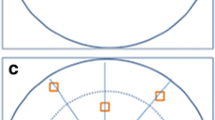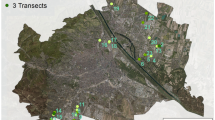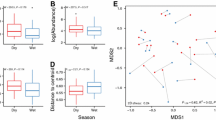Abstract
Biodiversity surveys are often hampered by the inability tocontrol extraneous sources of variability introduced intocomparisons of populations across a heterogenous landscape. If not specifically accounted for a priori, this noisecan weaken comparisons between sites, and can make itdifficult to draw inferences about specific ecologicalprocesses. We developed a terrain-based, paired-sitesampling design to analyze differences in aquaticbiodiversity between streams draining eastern hemlock (Tsuga canadensis) forests, and those draining mixedhardwood forests in Delaware Water Gap National RecreationArea (USA). The goal of this design was to minimize variancedue to terrain influences on stream communities, whilerepresenting the range of hemlock dominated streamenvironments present in the park. We used geographicinformation systems (GIS) and cluster analysis to define andpartition hemlock dominated streams into terrain types basedon topographic variables and stream order. We computedsimilarity of forest stands within terrain types and usedthis information to pair hemlock-dominated streams withhardwood counterparts prior to sampling. We evaluated theeffectiveness of the design through power analysis and foundthat power to detect differences in aquatic invertebratetaxa richness was highest when sites were paired and terraintype was included as a factor in the analysis. Precision ofthe estimated difference in mean richness was nearly doubledusing the terrain-based, paired site design in comparison toother evaluated designs. Use of this method allowed us tosample stream communities representative of park-wide forestconditions while effectively controlling for landscapevariability.
Similar content being viewed by others
References
Austin, M. P. and Heyligers, P. C.: 1989, ‘Vegetation survey design for conservation:Gradsect sampling of forests in north-eastern New South Wales’, Biol. Conserv. 50, 13–32.
Bailey, R. G.: 1996, Ecosystem Geography. Springer-Verlag, New York.
Band, L. E.: 1989, ‘Automating topographic and ecounit extraction from mountainous forested watersheds’, AI Appl. 3(4), 1–11.
Blaszczynski, J. S.: 1997, ‘Landform characterization with geographic information systems’, Photogr. Engin. Remote Sens. 63(2), 183–191.
Blaszczynski, J. S.: 2000, ‘GIS Analysis Methods for Mapping Morphologically Similar Terrains’, in Proceedings from the 2000 Annual Conference of the American Society for Photogrammetry & Remote Sensing, American Society for Photogrammetry & Remote Sensing, Bethesda, MD, CD-ROM (unpaginated).
Bourgeron, P. S., Humphries, H. C. and Jensen, M. E.: 1994, ‘General Sampling Design Considerations for Landscape Evaluation’, pp. 109–120, in M. E. Jensen and P. S. Bourgeron (eds), Eastside Forest Ecosystem Health Assessment, Volume II: Ecosystem Management and Principles, US Department of Agriculture, Forest Service, General Technical Report PNW-GTR-318.
Burrough, P. A.: 1986, Principles of Geographical Information Systems for Land Resources Assessment, Oxford University Press, New York.
Cochran, W. G.: 1983, Planning and Analysis of Observational Studies, John Wiley and Sons. New York.
Cochran, W. G.: 1977, Sampling Techniques, Third Edition, John Wiley and Sons. New York.
Cummins, K. W.: 1992, ‘Catchment Characteristics and River Ecosystems’, pp. 126–135, in: P. J. Boon, P. Calow and G. E. Petts (eds), River Conservation and Management. Wiley Publishers, West Sussex, England.
Davis, F. W., Stoms, D. M., Estes, J. E. and Scepan, J.: 1990, ‘An information systems approach to the preservation of biological diversity’, Int. J. Geogr. Infor. Syst. 4(1), 5–78.
Davis, F. W. and Goetz, S.: 1990, ‘Modeling vegetation pattern using digital terrain data’, Lands. Ecol. 4(1), 69–80.
Davis, F. W. and Dozier, J.: 1988, ‘Information analysis of a spatial database for ecological land classification’, Photogr. Engin. Remote Sens. 56(5), 605–613.
Davis, J. C.: 1986, Statistics and Data Analysis in Geology, John Wiley and Sons, New York.
Environmental Systems Research Institute (ESRI), Inc.: 1994, ArcInfo, Version 7.0. Redlands, CA.
Frissell, C. A., Liss, W. J., Warren, C. E. and Hurley, M. D.: 1986, ‘A hierarchical framework for stream habitat classification: Viewing streams in a watershed context’, Envir. Manage. 10, 199–214.
Gillison, A. N. and Brewer, K. R. W.: 1985, ‘The use of gradient directed transects or gradsects in natural resource surveys’, J. Envir. Manage. 20, 103–127.
Haila, Y. and Margules, C. R.: 1996, ‘Survey research in conservation biology’, Ecography 19, 323–331.
Jenson, S. K. and Dominque, J. O.: 1988, ‘Extracting topographic structure from digital elevation data for geographic information system analysis’, Photogr. Engin. Remote Sens. 54(11), 1593–1600.
Marsh, W. M.: 1983, Landscape Planning: Environmental Applications, John Wiley and Sons, New York.
McNab, W. H: 1991, ‘Terrain shape index: Quantifying effect of minor landforms on tree height’, Forest Sci. 35(1), 91–104.
Minshall, G. W., Petersen, R. C. Jr. and Nimz, C. F.: 1985, ‘Species richness in streams of different size from the same drainage basin’, Amer. Natural. 125, 16–38.
Myers, W. L. and Irish, R. R.: 1981, Vegetation Survey of Delaware Water Gap National Recreation Area: Final Report, USDI National Park Service, Mid-Atlantic Region.
Orwig, D. A. and Foster, D. R.: 1998, ‘Forest response to the introduced hemlock woolly adelgid in southern New England, USA’, J. Torrey Botan. Soc. 125, 60–73.
Osborne, L. L. and Wiley, M. J.: 1992, ‘Influence of tributary spatial position on the structure of warmwater fish communities’, Can. J. Fish. Aqua. Sci. 49, 671–681.
Poff, N. L.: 1997, ‘Landscape filters and species traits: towards a mechanistic understanding and prediction in stream ecology’, J. N. A. Benthol. Soc. 16, 391–409.
Roberts, D. W.: 1986, ‘Ordination on the basis of fuzzy set theory’, Vegatatio 66, 123–131.
SAS: 1990, SAS Language: Reference, Version 6, First Edition, Cary, N.C., SAS Institute, Inc. 1042 pp.
Schlesselman, J. J.: 1982, Case-Control Studies, Oxford University Press, New York.
Skidmore, A. K.: 1990, ‘Terrain position as mapped from a gridded digital elevation model’, Inter. J. Geogr. Infor. Syst. 4(1), 33–49.
Souto, D., Luther, T. and Chianese, B.: 1996, ‘Past and Current Status of HWA in Eastern and Carolina Hemlock Stands’, Proceedings of the First Hemlock Woolly Adelgid Review. USDA For. Serv., FHTET 96-10, 9–15.
Strahler, A. N.: 1964, ‘Quantitative Geomorphology of Drainage Basins and Channel Networks’, in Ven te Cow (ed.), Handbook of Applied Hydrology, McGraw-Hill, New York.
USGS: 1990, US GeoData Digital Line Graphs from 1:24,000-Scale Maps: Data Users Guide. National Mapping Program Technical Instructions, Data Users Guide 1, US Geological Survey, Department of the Interior, Reston, Va.
USGS: 1993, US GeoData Digital Elevation Models: Data Users Guide, National Mapping Program Technical Instructions, Data Users Guide 5, US Geological Survey, Department of the Interior, Reston, Va.
Wilkinson, L.: 1998, SYSTAT 8.0 Statistics, SPSS Inc., Chicago, IL. 1086 pp.
Zar, J. H.: 1984, Biostatistical Analysis, Second Edition, Prentice Hall, Englewood Cliffs, New Jersey.
Author information
Authors and Affiliations
Rights and permissions
About this article
Cite this article
Young, J.A., Smith, D.R., Snyder, C.D. et al. A Terrain-Based Paired-Site Sampling Design to Assess Biodiversity Losses from Eastern Hemlock Decline. Environ Monit Assess 76, 167–183 (2002). https://doi.org/10.1023/A:1015530712600
Issue Date:
DOI: https://doi.org/10.1023/A:1015530712600




